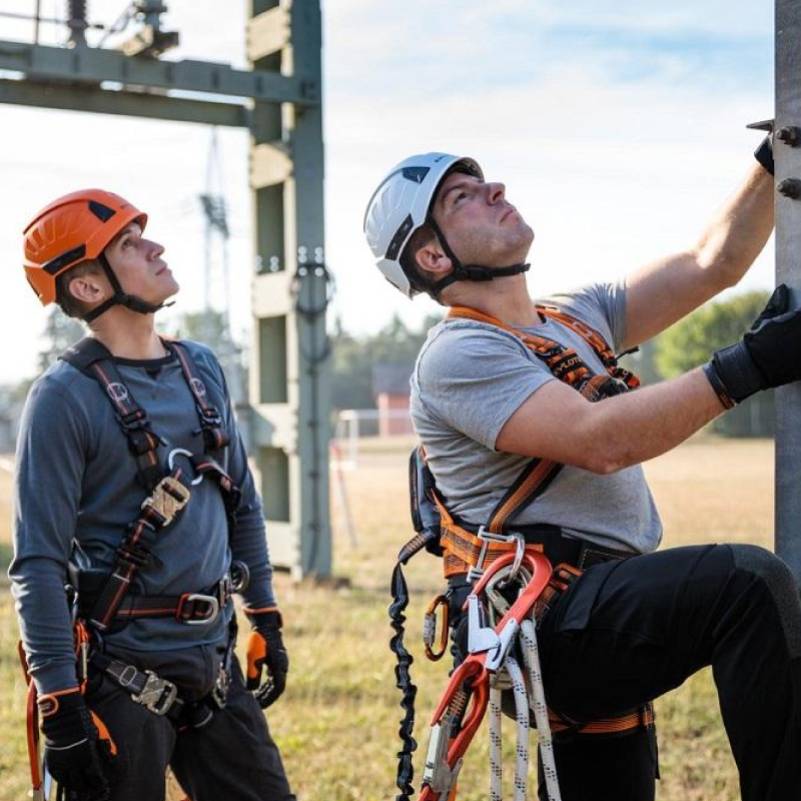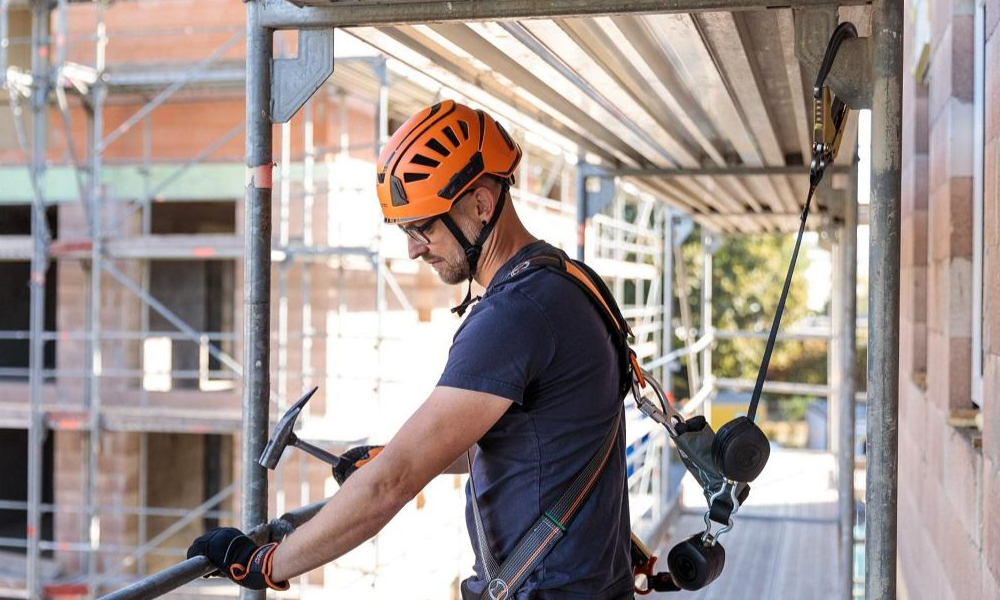Why the Switch to Safety Helmets is a Good Decision
Traumatic brain injuries (TBIs) happen frequently in industrial environments, including the construction, manufacturing, transportation, agriculture and mining sectors. However, the CDC states that the “construction industry has the greatest number of fatal and nonfatal traumatic brain injuries (TBIs) among U.S. workplaces.”

Why the Switch to Safety Helmets is a Good Decision en
09/12/2022
Traumatic brain injuries (TBIs) happen frequently in industrial environments, including the construction, manufacturing, transportation, agriculture and mining sectors. However, the CDC states that the “construction industry has the greatest number of fatal and nonfatal traumatic brain injuries (TBIs) among U.S. workplaces.”
Falls Make Up About 35 Percent of all Construction Accidents
Construction is a perilous industry with a cornucopia of risks and hazards due to dropped objects, trips, slips and falls, working at heights, struck-by accidents, exposure to chemicals and concrete hazards and the list goes on and on.
Although numerous risks co-exist at construction jobsites, it’s important to remember that falls make up about 35 percent of all construction accidents. According to OSHA, “65 percent of the construction industry works on scaffolds,” so construction workers are at high risk for TBIs and their life-threatening or life-long consequences.
Some common traumatic brain injuries that plague the construction industry include concussions (mild TBI), skull fractures, brain hemorrhages, head bruises or contusions or hematoma.
TBI can lead to severe disabilities, including amnesia, coma and even death. The injury is tricky too because symptoms, like persistent headaches, confusion and speaking more slowly than usual, may show up several days or weeks after the accident.
Harnesses, guardrail systems and personal fall arrest systems are key pieces of conventional fall protection when workers are working six feet or more above a lower level. This type of PPE helps prevent the fall from happening. However, when a worker slips, trips or falls or is smacked by a dropped object on his or her head, the proper type of head protection is needed.
Innovations in Head Protection
For over a century, hard hats reigned supreme as the go-to PPE for protection against head injuries. However, it is somewhat ironic that the iconic hard hat was not designed to protect from slips, trips and falls, which are how most head injuries occur, leading “to over half of fatal work-related TBIs,” according to a 2016 NIOSH study.
The traditional hard hat, while beloved by construction workers far and wide, was designed to defend against dropped objects and flying debris, providing protection primarily at the top of the head. The traditional hard hat was not engineered to protect against the injuries from slips, trips and falls, which are often angled impacts that affect the top, back and side of the head.
If a worker wearing a hard hat falls from a roof, ladder or scaffold, the hard hat may not protect him or her, especially if it falls off the worker’s head during the fall. Most hard hats don’t have built-in chin straps, which are necessary to keep the hard hat where it belongs—on the worker’s head. Plus, traditional hard hats don’t provide lateral or back-of-the-head protection, which is very important should an employee fall or trip.
Despite the cultural significance and long-term use of the hard hat, the safety industry is becoming more aware of the hard hat’s limitations. Is there a silver lining to these limitations? Yes. The hard hat’s limitations have become a springboard to innovation, giving rise to the safety helmet, which has its roots in the climbing and cycling helmets used in sports.
Hard Hats Versus Safety Helmets
Both hard hats and safety helmets provide protection against head injuries, but the engineering, advanced design and the features of the safety helmet offer more protection, especially where slips, trips and falls are concerned.
Falls are such a menace in construction worker fatalities that they are included in OSHA’s “Fatal Four” list, which also includes electrocutions, being struck by objects and being caught in or between objects.
Falls were responsible for 38 percent of all construction worker deaths in Fiscal Year 2020, so the importance of having enhanced head protection should be a primary consideration in every safety program. General contractor Clark Construction has done more than consider enhanced head protection, it has made safety helmets a requirement.
Clark Construction, the first general contractor to implement a corporate-wide safety helmet requirement, recently announced in a May 2022 press release that it “will require all craft workers to wear safety helmets that meet certain performance standards and that are equipped with an integrated four-point chin strap on all new projects starting on August 1, 2022.” This requirement further solidifies the company’s commitment to ensuring enhanced head protection for workers on its jobsites.
“Traditional hard hats are no longer the best option to protect the safety and well-being of the men and women on construction sites and just about everybody knows that,” said Kris Manning, senior vice president of safety at Clark. “The time is now for us to evolve as an industry and expedite the adoption of safety helmets.”
Five key benefits of choosing a safety helmet over a hard hat include:
- less chance of injury to the worker
- less worker’s compensation claims
- increased productivity
- reduced risk and fewer insurance claims
- longer life cycle as safety helmets typically last longer than hard hats

Don’t Let Cost Ambush Improved Safety
Granted, the investment in safety helmets is more costly upfront than hard hats, just like LED lightbulbs are more expensive than incandescent lightbulbs. But don’t let costs get in the way of a good decision.
When first introduced, the public resisted switching from incandescent lightbulbs to LED lightbulbs. Like safety helmets, the price was higher, and the cooler color of LED bulbs was different from the traditional amber light of incandescent bulbs that everyone was used to. Likewise, the sleek, low-profile shape of safety helmets is different from the traditional hard hat that construction and industrial workers are used to.
Our qualms about LED bulbs were eventually soothed when we saw how long they lasted and how they saved on electricity over time. Although more expensive upfront, the long-term advantages became obvious to everyone and now purchasing LED bulbs is the new normal, having a green impact to boot.
Perhaps safety helmets will follow the path of LED bulbs, becoming the new normal in industrial head protection, admired for its long-term protective advantages for both the worker and the company.
What’s Next for the Safety Helmet?
Increased awareness about the advantages of safety helmets will lead to more demand and growth for this product. Grandview Research reports that “the safety helmet market was valued at USD 1.8 billion in 2019 and is expected to grow at a compound annual growth rate (CAGR) of five percent to reach USD 2.72 billion by 2027.”
Futuristic technologies will continue to revolutionize head protection by turning safety helmets into a “wearable smart device,” complete with wireless connectivity and power management technologies. These innovations will allow workers to connect with a remote command center via sensors, camera, and microphones. A smart helmet’s remote communications and the ability to push a single button for help will improve job safety, productivity, activity tracking and provide the location of the worker should an emergency arise.
Another technological advance in head protection is the Multi-directional Impact Protection System (MIPS). By using a low-friction layer of polycarbonate plastic, MIPS allows the head to move inside the helmet, which reduces the rotational motion. The low-friction layer allows a sliding motion in any direction. When that rotational motion is redirected, the risk of brain tissue strain is reduced. This is important because construction accident impacts often occur with rotational motion, and our brains are about six to seven times more sensitive to rotational motion than to linear impacts.
Build it Better—Protect Workers Better
Construction pros try to build better every day to build our communities and roads and to restore our crumbling infrastructure. They play a big role in our lives, and they deserve better head protection—the kind that protects them from injuries at the top, back and side of the head. Construction work is demanding work. It’s physical. It’s dangerous. It’s hot and sweaty. It’s tough. And it’s rough out there.
Don’t let your construction site turn into a risky business for your work crews. Protect your crew with the best PPE and don’t compromise on head protection. When you make the switch to safety helmets, you’ll reduce traumatic brain injuries, save lives, and experience long-term cost savings from reduced accidents and insurance claims.
It’s a no-brainer because protecting the head with safety helmets is the safer solution.
Source: OH&S



